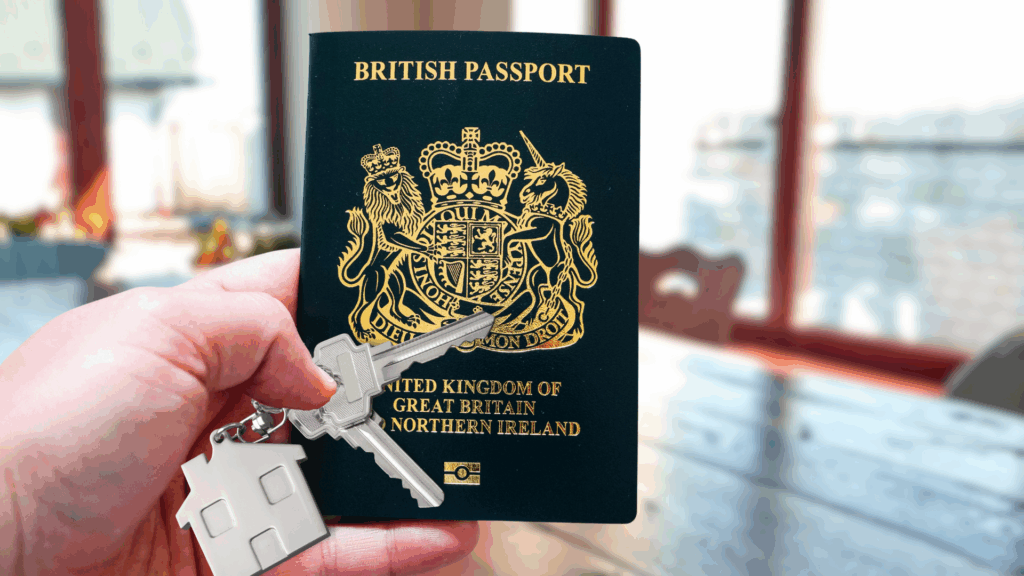- Can You Transfer a Mortgage to Another Person?
- How To Transfer a Mortgage to Another Person?
- Can You Add Someone to a Mortgage?
- How Changing Names on a Mortgage Affects Your Finances
- How To Remove a Name from a Joint Mortgage in the UK?
- How Do You Buy Someone Out of a House?
- Alternatives to Removing a Name from a Joint Mortgage
- Can You Walk Away from a Joint Mortgage?
- Key Takeaways
- The Bottom Line
How To Transfer, Add, Or Remove Names On A Joint Mortgage?

When you’re buying a home with someone else, you might opt for a joint mortgage. This means you’re both responsible for the loan.
It’s common among couples, friends, or family members pooling resources to buy property.
But what happens when circumstances change? Can you alter who’s on the mortgage?
In this guide, we’ll explain all you need to know about removing or adding someone to a mortgage.
Can You Transfer a Mortgage to Another Person?
Yes, you can transfer a mortgage to another person, but it’s not as simple as handing over your house keys.
It’s a detailed process often linked to major life changes like divorce, inheritance, or adding a partner.
Here’s what’s needed:
- Consent from all current mortgage holders
- Lender-approval of the new borrower
- Updated property deeds
- Possible stamp duty land tax payment
The process involves:
- Contacting your lender to discuss options
- Completing a new mortgage application
- Providing necessary documentation (proof of income, ID, etc.)
- Property valuation
- Conveyancing process to transfer legal ownership
- Finalising the new mortgage agreement
Transferring a mortgage can offer benefits like lower interest rates or better terms, but it may also incur fees and early repayment charges on your current mortgage.
Professional advice is crucial.
A qualified mortgage broker can help you understand your options, while a solicitor can handle the legal aspects of the transfer.
How To Transfer a Mortgage to Another Person?
As discussed, to transfer a mortgage, you’ll need to meet specific legal requirements.
First, both the current mortgage holder and the person receiving the mortgage must agree to the transfer.
You’ll also need your lender’s approval, as they’ll want to ensure the new borrower can afford the repayments.
The process typically begins with contacting your lender to discuss your options.
They’ll guide you through their specific requirements, which often include:
- Credit checks on the new borrower
- Income verification
- Property valuation
- Proof of identity and address
Lenders have different criteria for approving mortgage transfers. They’ll assess the new borrower’s creditworthiness, income stability, and overall financial situation.
If the new borrower doesn’t meet their criteria, the transfer may be denied.
Be prepared for costs like:
- Legal fees for conveyancing
- Valuation fees
- Potential early repayment charges on your current mortgage
- Stamp duty land tax (if applicable)
Before proceeding, consider the risks involved. The person taking on the mortgage becomes legally responsible for the debt.
If they fail to make payments, it could lead to repossession of the property.
Can You Add Someone to a Mortgage?
Adding someone to your mortgage can be helpful, whether it’s a partner moving in or needing extra income to qualify for a larger loan.
But it’s not a decision to take lightly.
To add someone to your mortgage, they must meet your lender’s criteria. This usually means having a good credit score, stable income, and manageable existing debts.
The process involves applying for a joint mortgage with your current lender or remortgaging with a new one.
Be aware that adding a name to your mortgage might affect your current terms and conditions.
Your lender could treat it as a new application, potentially changing your interest rate or loan term.
But it could also offer benefits like increased borrowing power and shared repayment responsibility.
You’ll need to provide documents similar to your original mortgage application, including:
- Proof of income
- Bank statements
- Credit reports
- Identification documents
Remember, adding someone to your mortgage also means adding them to the property’s title deeds, making them co-owners.
This is a significant legal step, so consider it carefully.
How Changing Names on a Mortgage Affects Your Finances
Changing names on a mortgage can have a big impact on your finances. It affects your credit score since the change gets reported to credit agencies.
If you remove your name, you’re no longer responsible for the debt, which can boost your borrowing capacity for future loans.
Mortgage terms and interest rates might change with new names. Lenders will reassess the application, which could lead to better or worse terms.
It’s crucial to stay financially stable during and after the change. Make sure everyone understands their new responsibilities and can handle any changes in repayments.
Future financial planning should account for these changes.
If you’ve taken on sole responsibility, you might need to adjust your budget and savings plans.
Benefits of adjusting mortgage ownership include:
- Improved borrowing capacity for the person removed from the mortgage
- Potential for better terms if the remaining party has a strong financial position
- Clearer financial separation in cases of relationship breakdown
Long-term, changing names on a mortgage affects your financial health and responsibility.
Understand the implications fully before proceeding, and always seek professional advice for such significant decisions.
How To Remove a Name from a Joint Mortgage in the UK?
Removing a name from a joint mortgage is common during divorces, separations, or when one party wants to take sole responsibility for the property.
It’s a process known as a ‘transfer of equity‘.
Here’s how you can do it:
- Contact your lender to discuss your options. Inform them of your intention to remove a name from the joint mortgage. They will assess if the remaining borrower can afford the mortgage alone, reviewing income, outgoings, and credit history.
- Apply for a transfer of equity with your lender. Submit a formal application and provide necessary documentation like proof of income and identification.
- Complete a new mortgage application if required. Sometimes, you may need to re-mortgage the property. This involves applying for a new mortgage in the remaining borrower’s name. The lender will conduct a credit check and may require a fresh property valuation.
- Instruct a solicitor to handle the legal process. Your solicitor will prepare the transfer deed and ensure all legal documents are correctly filed.
- Submit all required documents to your solicitor, including the signed transfer deed and proof of identity. Both parties will need to sign the transfer deed in the presence of a witness.
- Register the change with the Land Registry. Your solicitor will file the necessary paperwork to update the property ownership records. Once processed, a new title deed reflecting the change will be issued.
Costs can include legal fees, valuation fees, stamp duty (if applicable), and early repayment charges (if any).
Keep your finances steady during this time, as missed payments can harm both parties’ credit scores.
How Do You Buy Someone Out of a House?
Buying someone out of a house typically happens when co-owners decide to separate, such as after a divorce or business split.
This involves one owner purchasing the other’s share of the property’s value.
First, get a professional valuation to determine the property’s worth. This gives both owners a clear picture of the property’s value.
Next, calculate each owner’s share of the equity – the difference between the property’s value and the mortgage.
For instance, a £300,000 property with a £150,000 mortgage has £150,000 equity. If ownership is split equally, each owner holds £75,000 equity.
Agree on the buyout terms, including the payment amount and how it will be paid. Clearly document this agreement.
Update the property’s title deeds to reflect the ownership change, possibly involving a solicitor.
If you need funds, you might need to remortgage the property in your name. This requires paperwork and proof of funds.
Carefully consider the financial impact of a remortgage as you’ll be solely responsible for the loan.
Once agreed, complete the buyout by paying the other owner, transferring ownership through your solicitor, and registering the new title deeds.
Seek advice from financial and legal experts to understand the tax, legal, and financial implications. This guidance helps ensure a smooth process and fair treatment for both parties.
Alternatives to Removing a Name from a Joint Mortgage
While removing a name from a joint mortgage is common, it’s not always the best solution.
Consider these alternatives:
- Selling the property and splitting proceeds – This clean break allows both parties to move on. But consider market conditions and potential capital gains tax before proceeding.
- Renting out the property – This can cover mortgage payments while you decide on long-term plans. Remember, you’ll need landlord insurance and to inform your lender.
- Remortgaging – You might find better terms that make the mortgage more manageable for one party to take on alone.
Each option has pros and cons. Selling provides a clean break but may be emotionally difficult. Renting out the property keeps your investment but requires ongoing cooperation. Remortgaging could improve your financial situation but may incur fees.
Legal considerations include updating tenancy agreements, tax implications, and potentially seeking court orders if agreements can’t be reached amicably.
Open communication between all parties is crucial. Consider mediation if you’re struggling to agree.
Can You Walk Away from a Joint Mortgage?
Walking away from a joint mortgage isn’t as simple as packing your bags and leaving.
Both parties remain legally and financially responsible for the mortgage, regardless of who lives in the property or makes the payments.
Consequences of walking away can be severe:
- Damage to your credit score
- Legal action from your lender
- Difficulty obtaining credit in the future
- Potential homelessness if the property is repossessed
To legally exit a joint mortgage agreement, you need to either sell the property, transfer the mortgage to the other party, or remortgage in one person’s name.
Each option requires the lender’s approval and cooperation from all parties involved.
If you’re struggling with payments, consider alternatives like:
- Seeking a payment holiday from your lender
- Temporarily renting out the property
- Exploring government support schemes
AlInstead of removing a name, you can sell the property and split the money, rent it out, or remortgage for better terms.
Always seek professional advice when dealing with joint mortgage issue
Key Takeaways
- You can transfer a mortgage to another person, but it’s complicated. You need consent from everyone involved, approval from your lender, updated property deeds, and might have to pay stamp duty.
- If you need to remove someone from a joint mortgage, like in a divorce, you’ll need to talk to your lender, apply for a transfer of equity, hire a solicitor, and register the change with the Land Registry.
- Instead of removing a name, you can sell the property and split the money, rent it out, or remortgage for better terms.
- Adding someone to your mortgage can help you get a bigger loan, but they need to meet your lender’s criteria. This might change your mortgage terms and involves applying for a joint mortgage or remortgaging.
The Bottom Line
Changing the names on your mortgage is no small task. It’s a serious move with legal and financial strings attached.
Before you leap, talk to your lender. Have a chat with a solicitor. And don’t forget a top-notch mortgage broker. They’re your guides in this complex journey.
A whole-of-market broker is your secret weapon. They scan the market, finding the best deals from a range of lenders.
Their advice? Unbiased and tailored just for you.
With a good broker, the paperwork isn’t a nightmare. They steer you through the process, ensuring you land the best mortgage terms.
Looking for the right broker? We’ve got you covered.
Get in touch, and we’ll connect you with a qualified expert who can help you navigate adding or removing names from your mortgage.
Get Matched With Your Dream Mortgage Advisor...

Frequently asked questions
What is the Land Registry and why is it important?
The Land Registry is a UK government department that keeps track of who owns what when it comes to land and property. It’s vital when you’re changing names on a mortgage because it makes sure the legal records are up-to-date and accurate.
How do I update the Land Registry after changing names on a mortgage?
To get the Land Registry updated, you’ll need to fill in and submit the right forms. Usually, a solicitor helps with this.
You’ll need the Transfer of Equity form (TR1), proof of identity, and the necessary fees.
Are there any fees associated with updating the Land Registry?
Yes, there are fees. They vary depending on the transaction and the property’s value. Your solicitor will give you the lowdown on the exact costs you’ll need to cover.
How long does it take to update the Land Registry?
Updating the Land Registry can take anywhere from a few weeks to a couple of months. It depends on how complex your case is and how busy the Land Registry is at the time.
Do I need to inform my lender before updating the Land Registry?
Absolutely. Let your lender know before you update the Land Registry. They need to agree to any changes in ownership because it impacts the mortgage agreement.
They’ll likely reassess the remaining borrower’s finances to make sure they can handle the mortgage on their own.




